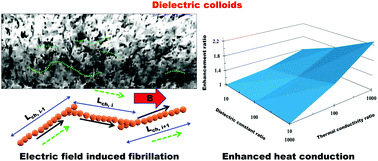Electrohydrodynamic fibrillation governed enhanced thermal transport in dielectric colloids under a field stimulus
Abstract
Electrorheological (ER) fluids are known to exhibit enhanced viscous effects under an electric field stimulus. The present article reports the hitherto unreported phenomenon of greatly enhanced thermal conductivity in such electro-active colloidal dispersions in the presence of an externally applied electric field. Typical ER fluids are synthesized employing dielectric fluids and nanoparticles and experiments are performed employing an in-house designed setup. Greatly augmented thermal conductivity under a field's influence was observed. Enhanced thermal conduction along the fibril structures under the field effect is theorized as the crux of the mechanism. The formation of fibril structures has also been experimentally verified employing microscopy. Based on classical models for ER fluids, a mathematical formalism has been developed to predict the propensity of chain formation and statistically feasible chain dynamics at given Mason numbers. Further, a thermal resistance network model is employed to computationally predict the enhanced thermal conduction across the fibrillary colloid microstructure. Good agreement between the mathematical model and the experimental observations is achieved. The domineering role of thermal conductivity over relative permittivity has been shown by proposing a modified Hashin–Shtrikman (HS) formalism. The findings have implications towards better physical understanding and design of ER fluids from both ‘smart’ viscoelastic as well as thermally active materials points of view.



 Please wait while we load your content...
Please wait while we load your content...